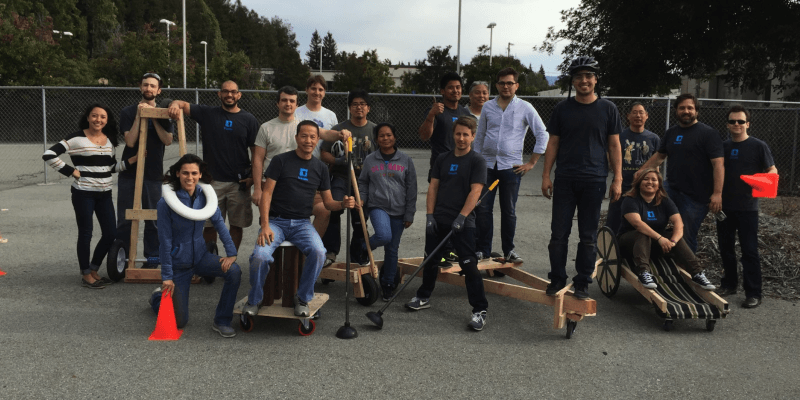
Updated on: April 4, 2019
Connecting Remote Workers: Double Robotics Interview, Part 1
Managing a distributed team and connecting remote workers can present a gauntlet of challenges to companies that are transitioning to telecommuting. One of the most cutting-edge–and fun–tools for successfully managing remote employees sounds like something from the future: the telepresence robot.
A global leader in developing telepresence robots is Double Robotics, a technology company located in Sunnyvale,California, “in the heart of the Silicon Valley.” Double Robotics is the creator of the Double, a telepresence robot that helps “telecommuters feel more connected to their colleagues, by giving them a physical presence wherever they need to be.”
Here’s how Double Robotics is connecting remote workers:
Working from Home While Participating in Office Culture
Double offers many advantages for companies with remote workers. “Having your own Double in the office means you can be free to roam around anywhere without scheduling a call or meeting,” said RJ Wafer, head of business development at Double Robotics. “Double takes everything you love about video calls on an iPad and places that on a mobile base that puts the remote worker in control. By combining cutting-edge technology with an intuitive, elegant design, Double is the ultimate tool for telecommuters.”
Double Robotics has successfully put the Double to use for its own remote workers. Three of the company’s 25 team members work remotely from New York, and one telecommutes from Kansas–about 16 percent of Double Robotics’ total team.
Maintaining a Remote Presence
At Double Robotics, the heart of the mission is not just about remote work, but about “remote presence,” Wafer said. To that end, the Double literally allows remote workers to be “in two places at once.” Workers in telecommuting jobs have “the opportunity to engage and experience remotely, without the tethers of a laptop or a human to guide you [to] another place at the same time.”
Wafer, formerly a longtime resident of Brooklyn, New York, was the first and, for a time, the only user of the Double at Double Robotics. “It was a daunting prospect to move to the Bay area, away from family and friends, and my entire life,” Wafer said. “Double Robotics co-founders Marc DeVidts and David Cann and I agreed to let me use the Double. I am my own use case!”
Seamless Remote Integration
Today, all four remote workers at Double Robotics use the Double and “the integration is pretty seamless,” Wafer said. After some initial experimentation, “We have found that you simply do everything you would for a physically present worker, except buy them lunch for the office.”
At Double Robotics, it helped tremendously that the company culture is largely informal. “We are tinkerers, and we like to test things out in different ways to make sure we know what happens,” Wafer said. That experimentation and first-hand experience has assisted Double Robotics in helping customers determine what might work best for them.
Remote Benefits: More Productivity, More Freedom
“We take the best practices we develop for each individual and go with it for them,” Wafer said. “In the end, it is about productivity and freedom, so formalized rules (aside from NEVER EVER shutting a door to the Double office) would inhibit use of comfort…. We leave people to their own devices, literally.”
The Double has helped to maintain “levels of happiness” and increase flexibility at Double Robotics. “People no longer have to sit in an office from 9 to 5; rather, working remotely allows for greater freedom and flexibility,” Wafer said. “This, in turn, can create higher levels of employee satisfaction, and maintain or increase employee retention rates.”
Advice for Considering Remote Options
It could be that you’re a supervisor whose company is “on the fence” about offering remote work options. If that’s the case, consider trying the flexibility of remote work on for size. “It doesn’t hurt to give it a try and present the idea to your company,” Wafer said. “Give your employees some time to test it out and see if it works for them. Giving employees the option to work remotely will show them how valued and trusted they are.”
Wafer’s own history serves as a great example. “It took a little tinkering to find the right comfort level with it all,” Wafer said. “First, I was only logging on for chats.” Over time, as everyone grew more familiar with having the Double around, the contact increased to “hanging out” for casual hallway encounters. That still was not enough, Wafer said. “No bueno.”
Figuring Out How the Double Helps Connecting Remote Workers
Ultimately, Double Robotics hit on a solution for using the Double that worked. “We just put me and my Double into the office I use when I go to Sunnyvale,” at the company’s headquarters, Wafer said. “It was perfect.”
The advantages? “People always know where to find me, simply ask if I am ‘in,’” Wafer said. “Sometimes people are shocked I am physically in, so it is fun to see their faces when they’re surprised by that.”
Now, interaction using the Double “really feels normal,” Wafer said. “I am there when they need me, and can drive and find them when I need to have a quick chat. Now, I regularly have Double-to-Double chats with my colleagues. Seeing two robots talking in our office is a normal thing.”
By Conor McMahon | Categories: Remote Management



